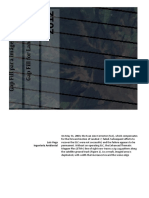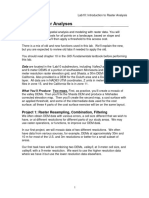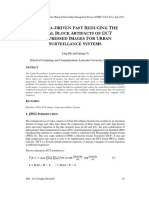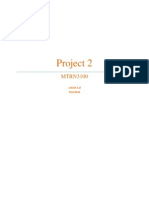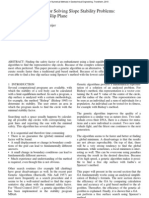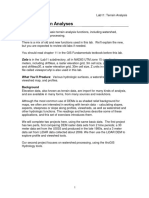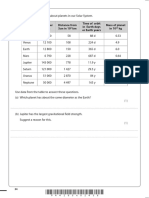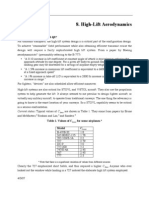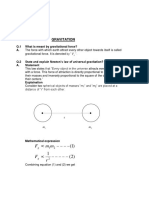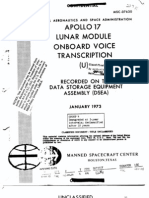Metode Gap Fill Menggunakan ArcGis
Metode Gap Fill Menggunakan ArcGis
Uploaded by
ardhi336Copyright:
Available Formats
Metode Gap Fill Menggunakan ArcGis
Metode Gap Fill Menggunakan ArcGis
Uploaded by
ardhi336Original Description:
Original Title
Copyright
Available Formats
Share this document
Did you find this document useful?
Is this content inappropriate?
Copyright:
Available Formats
Metode Gap Fill Menggunakan ArcGis
Metode Gap Fill Menggunakan ArcGis
Uploaded by
ardhi336Copyright:
Available Formats
G
a
p
F
i
l
l
f
o
r
L
a
n
d
s
a
t
I
m
a
g
e
s
2
0
1
2
G
a
p
F
i
l
l
p
a
r
a
i
m
g
e
n
e
s
L
a
n
d
s
a
t
On May 31, 2003, the Scan Line Corrector (SLC), which compensates
for the forward motion of Landsat 7, failed. Subsequent efforts to
recover the SLC were not successful, and the failure appears to be
permanent. Without an operating SLC, the Enhanced Thematic
Mapper Plus (ETM+) line of sight now traces a zig-zag pattern along
the satellite ground track (Figure 1). As a result, imaged area is
duplicated, with width that increases toward the scene edge
Luis Vega
Ingeniera Ambiental
MODEL: Gap Fill for Landsat 7 images A correction of SLC-off
AUTHOR: Luis Vega Bustillos, Environmental Engineer
E-MAIL: luispvb@gmail.com
DATE: July 2012
About SLC-off
On May 31, 2003, the Scan Line Corrector (SLC), which compensates for the forward motion of
Landsat 7, failed. Subsequent efforts to recover the SLC were not successful, and the failure
appears to be permanent. Without an operating SLC, the Enhanced Thematic Mapper Plus
(ETM+) line of sight now traces a zig-zag pattern along the satellite ground track (Figure 1). As
a result, imaged area is duplicated, with width that increases toward the scene edge.
Figure 1. SLC Failure
The Landsat 7 ETM+ is still capable of acquiring useful image data with the SLC turned off,
particularly within the central part of any given scene. The Landsat 7 ETM+ therefore continues
to acquire image data in the "SLC-off" mode. All Landsat 7 SLC-off data are of the same high
radiometric and geometric quality as data collected prior to the SLC failure.
The SLC-off effects are most pronounced along the edge of the scene and gradually diminish
toward the center of the scene (Figure 2). The middle of the scene, approximately 22
kilometers wide on a Level 1 (L1G, L1Gt, L1T) product, contains very little duplication or data
loss, and this region of each image is very similar in quality to previous ("SLC-on") Landsat 7
image data.
Figure 2. Complete Landsat 7 scene showing affected vs. unaffected area.
An estimated 22 percent of any given scene is lost because of the SLC failure. The maximum
width of the data gaps along the edge of the image would be equivalent to one full scan line,
or approximately 390 to 450 meters. The precise location of the missing scan lines will vary
from scene to scene.
SOURCE: USGS. (2010). SLC-off Products: Background. Obtenido de USGS - Landsat Missions:
http://landsat.usgs.gov/using_Landsat_7_data.php
Algorithms for the correction
After reviewing various methodologies proposed by the USGS and by independent authors
raised some difficulties in the application. Among the methods outlined is the suggested by the
USGS to use a mosaic of at least 2 images of the same sector.
The main obstacle to using the above method was implemented in software, but a group of
scientists can adapt the method to work. Although in my opinion It doesdnt produce good
results.
The methods can be found at:
http://landsat.usgs.gov/sci_an.php
The method developed
First, the Fill Gap model was conducted in a practical and simplified way. I chose to work in
ArcGIS Desktop Platform 9.3 10 for the experience to be had with this software.
The algorithm that is created is shown in the following flowchart:
Gap Filling
Identify invalid pixcels
Pixel=0
Erase pixel = 0
(SetNull)
Yes
Keep pixel value
No
Interpolate
values with
valid data
(Filter LOW)
Build attributes
table
Raster witouth
values 0"
Smoothed
Raster
Filling gaps:
Original Raster= 0
Take the value
of Raster
original
Take the value
of Smoothed
Raster
No
Yes
Filled Raster
Original Raster:
band.tif
Process
Condition
Start
Result
Leyend:
The Original Raster can be any Landsat band or any clip
The model must be executed many times as needed
The Filled Raster can be used like a new original Raster
Description of the algorithm:
1. Select one to one Landsat bands that will be filled
2. The selected band will be our "Original Raster", we may even make a cut in our area of
interest to optimize model performance.
3. Create the table of attributes for the Original Raster, is important because we are working
with ArcGIS.
4. By the condition "value = 0" delete cells with values of 0, using the tool SetNull
5. We proceed to use the Neighborhood tools, in this case we use the Filter LOW. This will
create a Smoothed Raster that fills the gaps with an average cell.
About the use of Filter LOW. - This point is one of the most important model, here are filled
the gaps of the image, the same can use different tools from which are Block Statistics,
Statistics Focal these two options fill with statistics (means, medians, etc..). Filter LOW was
chosen because of my appreciation is the one with better results, in part because it makes
processing of data on the type of interpolation. Despite my choice can still testing the use of
the Statistics Tools (Block or Focal).
6. Finally replace the cells with value = 0 of the Original Raster to Raster Smoothed values,
using the tool condition "Con"
The Gap Fill in ArcGis 9.3 10
Part1
Part2
Part3
NOTE: If you find another Neighborhood tools (Focal or Block Statistics) best suited to your
project you must replace Filter and Filter (2) by your new choice.
The Link
You can download the model here:
https://rapidshare.com/files/1632645659/GapFill.tbx
Or you can send me a e-mail to luispvb@gmail.com or nomoxxx@gmail.com
Annex: How Filter Works
SOURCE:
http://webhelp.esri.com/arcgisdesktop/9.3/index.cfm?TopicName=How%20Filter%20works
Filter calculates new z-values by centering the specified 3 x 3 filter over each input
raster cell. As the filter is passed over each cell, the center is assigned the sum of
the products of the cell value and the corresponding operand in the 3 x 3 filter.
Consider the following nine raster cells and 3 x 3 filter:
The output raster cell at the center of the filter (Z5) is assigned a z-value based on
the following formula:
Z = Z1*F1 + Z2*F2 + Z3*F3 + ... + Z9*F9
When an input raster cell on the edge of the filter has a NoData value, the z-value
of the cell is substituted for the missing z-values.
On the edges of the raster, the filter lies partially outside the raster. When this
occurs, the z-value of the cell at the center of the filter is substituted for the
missing z-values.
Low
The LOW option is an averaging filter. The nine z-values are weighted
equally to calculate the value of the center cell.
The sum of the weights for the low pass filter is 1.000. This ensures that the
general elevation of the surface is maintained after smoothing.
The 3 x 3 filter for the LOW option is:
1/9 1/9 1/9
1/9 1/9 1/9
1/9 1/9 1/9 (where 1/9 is approximately = 0.11111...)
In the following example, the input raster has an anomalous data point
caused by a data collection error. The averaging characteristics of the LOW option
have smoothed the anomalous data point.
Example
This example shows the resulting raster generated by FILTER with the LOW option
on a demonstration raster. Partial listings of the input and output raster cell values
are provided for comparison. Note how the NODATA locations are processed.
2.000 3.000 4.000 5.000 6.000
2.000 3.000 4.000 NODATA 6.000
2.000 3.000 4.000 5.000 6.000
2.000 30.000 4.000 5.000 NODATA
1.000 2.000 2.000 3.000 NODATA
After the low pass filter is performed, the values on the output raster are:
2.333 3.000 3.889 5.000 5.778
2.333 3.000 3.889 NODATA 5.778
5.333 6.000 6.889 4.889 5.778
5.000 5.556 6.444 4.333 NODATA
4.667 5.111 5.889 3.111 NODATA
MODELO: Gap Fill para imagines Landsat 7Una alternativa de correccin al SLC-off
AUTOR: Luis Vega Bustillos, Ingeniero Ambiental
E-MAIL: luispvb@gmail.com
FECHA: Julio de 2012
Sobre el SLC-off
Las imgenes del satlite Landsat 7 a partir del 2003 sufre del fallo en su sistema SLC, el SLC
es la parte del sensor ETM+ que compensa el movimiento hacia adelante del satlite durante la
adquisicin de las imgenes. Sin el SLC, el rea escaneada por el sensor delinea un patrn de
zigzag provocando un bandeado o efecto gaps en la imagen, como se muestra a continuacin:
Una vez revisados varias metodologas propuestas por la USGS y por autores independientes
surgieron algunas dificultades para su aplicacin. Entre los mtodos destacados est el
sugerido por la USGS para usar un mosaico de por lo menos 2 imgenes del mismo sector.
El principal obstculo para utilizar el anterior mtodo fue la implementacin en un software;
sin embargo un grupo de cientficos puedo adaptarlo para que el mtodo trabaje. A pesar de
esto no se obtuvieron buenos resultados.
El mtodo creado
En primer lugar, el modelo Gap Fill se llev a cabo de una forma prctica and simplificada. Se
eligi trabajar en la plataforma ArcGis Desktop 9.3 10 por la experiencia que se tena con este
software.
El algoritmo que se cre se muestra en el siguiente diagrama de flujo:
Relleno de
gaps
Identificacin
de datos no vlidos
Pixel=0
Borrar datos de
pixeles = 0
(SetNull)
Si
Mantener valor
de pixeles
No
Interpolar
valores con los
datos vlidos
(Filter LOW)
Construir tabla
de atributos del
raster
Raster sin
valores de 0
Raster
homogenizado
Rellenar gaps:
raster original = 0
Tomar valor del
Raster original
Tomar valor del
Raster
Homogenizado
No
Si
Raster
Rellenado
Raster Original:
banda .tif
Proceso
Desicin
Inicio
Resultado
Leyenda
El Raster Original es una banda del sensor Landsat o a su vez cualquier
recorte de la banda de tipo raster:
El mdulo se puede realizar las veces necesarias:
El Raster Rellenado puede utilizarse en un nuevo proceso sin ningn
problema, entonces vendra a ser el nuevo Raster Original
Descripcin del algoritmo:
1. Seleccionamos una a una las bandas Landsat que sern rellenadas
2. La banda elegida ser nuestro "Original Raster", inclusive podramos hacer un recorte del
nuestra rea de inters para optimizar el rendimiento del modelo.
3. Creamos la tabla de atributos para el Original Raster, es importante porque estamos
trabajando con ArcGis.
4. Mediante la condicin "value=0" borramos las celdas con valores de 0, para esto aplicamos
la herramienta SetNull
5. Procedemos a usar los Neighborhood tools, en este caso usaremos la herramienta Filter
LOW. Esto nos crear un Smoothed Raster que rellena los vacos mediante un promedio de
celdas.
Aclaracin sobre el uso de Filter LOW.- Este punto es uno de los ms importantes del modelo,
aqu se rellenan los gaps de la imagen, para lo mismo se puede utilizar distintas herramientas
entre las cuales estn Block Statistics; Focal Statistics estas dos con opciones de relleno
mediante estadstica (medias, medianas, etc.). Se escogi Filter LOW porque segn mi
apreciacin es el que presenta mejores resultados, en parte porque hace un tratamiento de
datos del tipo de interpolacin. A pesar de mi eleccin se puede seguir probando el uso de los
Statistics Tools (Block or Focal)
El Modelo dentro de ArcGis 9.3 y 10
Parte1
Parte2
Parte3
NOTA: Si se identifica una opcin de relleno dentro de Focal o Block Statistics que se adapte
mejor a su rea de estudio pueden incorporarla al modelo reemplazando Filter y Filter (2) por
la nueva herramienta
Los links de descarga:
https://rapidshare.com/files/1632645659/GapFill.tbx
Si por alguna razn se desactiva pueden escribirme un a e-mail a luispvb@gmail.com or
nomoxxx@gmail.com
You might also like
- Fragstat v4 TutorialDocument33 pagesFragstat v4 Tutorialulloa18No ratings yet
- Oasis Montaj Complete Workflow TutorialDocument3 pagesOasis Montaj Complete Workflow Tutorialinung84No ratings yet
- Sample Open Drone MapDocument8 pagesSample Open Drone MapagungmalayantapirNo ratings yet
- World of Darkness - Mirrors - Infinite MacabreDocument30 pagesWorld of Darkness - Mirrors - Infinite Macabrewillibm92% (12)
- JFK & UFO Military-Industrial Conspiracy and Cover-Up From Maury Island To Dallas - Kenn ThomasDocument267 pagesJFK & UFO Military-Industrial Conspiracy and Cover-Up From Maury Island To Dallas - Kenn ThomasCarlos Rodriguez100% (2)
- Gap FillDocument12 pagesGap FillAntonio J. Esteban CampuzanoNo ratings yet
- Analysis and Results: 1.1 Experimental DataDocument35 pagesAnalysis and Results: 1.1 Experimental DatasolidmasteryNo ratings yet
- Landsat SLC Gap Fill MethodologyDocument5 pagesLandsat SLC Gap Fill Methodologysss4sssNo ratings yet
- L10 Raster Analysis - ArcProDocument19 pagesL10 Raster Analysis - ArcProNabaraj NegiNo ratings yet
- Allen Exercise Land Cover Change in Ok FinalDocument30 pagesAllen Exercise Land Cover Change in Ok FinalEmil Salim RasyidiNo ratings yet
- 05 Ras3.AnalysisPropertiesDocument10 pages05 Ras3.AnalysisPropertiesJames LeeNo ratings yet
- Spatial Density Distribution: The Reference LibraryDocument8 pagesSpatial Density Distribution: The Reference LibraryIoana VizireanuNo ratings yet
- A Matlab GUI For Use With ISOLA Fortran Codes: Esokos@upatras - GR Jz@karel - Troja.mff - Cuni.czDocument34 pagesA Matlab GUI For Use With ISOLA Fortran Codes: Esokos@upatras - GR Jz@karel - Troja.mff - Cuni.czGunadi Suryo JatmikoNo ratings yet
- Actin Flow Metamorph Analysis ProcedureDocument5 pagesActin Flow Metamorph Analysis Procedurebackup.data.drive.03No ratings yet
- SLEUTH Training ManualDocument20 pagesSLEUTH Training ManualBiagio Antonio Maionese MaimoneNo ratings yet
- Rasterization Algorithms: Table of ContentsDocument14 pagesRasterization Algorithms: Table of Contentsmuskii25No ratings yet
- Eo Learn 2Document18 pagesEo Learn 2Trung HoàngNo ratings yet
- Lab 9 GeoprocessingDocument25 pagesLab 9 GeoprocessingnayabNo ratings yet
- Thesis On Image Processing PDFDocument7 pagesThesis On Image Processing PDFmarilynmarieboston100% (2)
- GEOBIA in ArcGIS PDFDocument43 pagesGEOBIA in ArcGIS PDFIlmer Yoel Villanueva Sarango100% (2)
- Tu 05 03 Faults FracturesDocument2 pagesTu 05 03 Faults FracturesTika Roswina PertiwiNo ratings yet
- LICSAR Time Series TutorialDocument10 pagesLICSAR Time Series TutorialLore Cardenas AguirreNo ratings yet
- LRM Toolbox For ArcGIS ManualDocument7 pagesLRM Toolbox For ArcGIS ManualIoana PavelNo ratings yet
- River2D Examples PDFDocument23 pagesRiver2D Examples PDFfrankie986No ratings yet
- Compositeimageassignment Filled in For SureDocument10 pagesCompositeimageassignment Filled in For Sureapi-278321703No ratings yet
- Water Sheds and Stream DelineationDocument37 pagesWater Sheds and Stream DelineationMateo Trujillo CaleñoNo ratings yet
- Iterated Graph Cuts For Image SegmentationDocument10 pagesIterated Graph Cuts For Image Segmentationankit407No ratings yet
- GeoprocessingDocument6 pagesGeoprocessingYusfaryan DisaputraNo ratings yet
- Big Data-Driven Fast Reducing The Visual Block Artifacts of DCT Compressed Images For Urban Surveillance SystemsDocument11 pagesBig Data-Driven Fast Reducing The Visual Block Artifacts of DCT Compressed Images For Urban Surveillance SystemsLewis TorresNo ratings yet
- Lidar For BasemapsDocument31 pagesLidar For BasemapsAnildaMariachiNo ratings yet
- Surpac 6.7.2 Release NoteDocument5 pagesSurpac 6.7.2 Release NotecalzadagiancarloNo ratings yet
- Raster Tutorial ArcgisDocument21 pagesRaster Tutorial ArcgisMihai MereNo ratings yet
- "GrabCut" - Interactive Foreground Extraction Using Iterated Graph CutsDocument6 pages"GrabCut" - Interactive Foreground Extraction Using Iterated Graph CutsdiegomfagundesNo ratings yet
- 07 Ras5.FunctionsDocument8 pages07 Ras5.FunctionsJames LeeNo ratings yet
- Ijcet: International Journal of Computer Engineering & Technology (Ijcet)Document8 pagesIjcet: International Journal of Computer Engineering & Technology (Ijcet)IAEME PublicationNo ratings yet
- Geog 325 Lab 7Document11 pagesGeog 325 Lab 7kelliahenry8No ratings yet
- Project 2Document12 pagesProject 2Ashish LalNo ratings yet
- L9 BufferingDocument13 pagesL9 BufferingHafid Windu ArdiNo ratings yet
- Scale Estimation and Keypoint Description: Li YichengDocument10 pagesScale Estimation and Keypoint Description: Li Yichengapi-303634380No ratings yet
- Guide For LULC PredictionDocument7 pagesGuide For LULC PredictionSANOUDJI JEANNo ratings yet
- Hydrological Analysis With ArcGISDocument11 pagesHydrological Analysis With ArcGISvaskotsNo ratings yet
- Stream Network and Watershed Delineation Using Spatial Analyst Hydrology ToolsDocument16 pagesStream Network and Watershed Delineation Using Spatial Analyst Hydrology ToolsGeo SpatialistNo ratings yet
- VLA Continuum Tutorial 3C391-CASA4.6 - CASA GuidesDocument27 pagesVLA Continuum Tutorial 3C391-CASA4.6 - CASA GuidesSoumyadeep DasNo ratings yet
- Modeling A Multi-Seam Coal Reserve Using RockworksDocument10 pagesModeling A Multi-Seam Coal Reserve Using RockworksWahyudi KurniaNo ratings yet
- Roya Full PaperDocument17 pagesRoya Full PaperMuh SadiqNo ratings yet
- On Garp: Preparing Environmental DataDocument12 pagesOn Garp: Preparing Environmental DataDario NavarreteNo ratings yet
- Bachelor Thesis Informatik BeispielDocument6 pagesBachelor Thesis Informatik Beispielstephanierivasdesmoines100% (1)
- SIDE User Guide Grabs SAGA 2 06 20101215Document2 pagesSIDE User Guide Grabs SAGA 2 06 20101215Ashish Kr RoshanNo ratings yet
- Exercise3 22032017 PDFDocument2 pagesExercise3 22032017 PDFalamgirNo ratings yet
- Illustrate in 3-D The Satellite Orbits: Exercise 3, "Navigation Solution + DGNSS + SBAS", 22.03.2017Document2 pagesIllustrate in 3-D The Satellite Orbits: Exercise 3, "Navigation Solution + DGNSS + SBAS", 22.03.2017Alamgir KhanNo ratings yet
- Slope Stability - General AlgorithmDocument6 pagesSlope Stability - General AlgorithmChinnaswamy GounderNo ratings yet
- Esse 3600Document15 pagesEsse 3600api-324911878100% (1)
- MAUD Tutorial - Hippo Texture Analysis Wizard: 1 Introduction and PurposeDocument11 pagesMAUD Tutorial - Hippo Texture Analysis Wizard: 1 Introduction and PurposeRicardinho T Aureliano Jr.No ratings yet
- SPE-197932-MS Decline Curve Analysis Using Artificial IntelligenceDocument13 pagesSPE-197932-MS Decline Curve Analysis Using Artificial IntelligenceGHIFFARI PARAMANTA ELBEESNo ratings yet
- Map AlgebraDocument11 pagesMap AlgebraOsarenomase IyamuNo ratings yet
- L11watershed Profiles ArcgisproDocument15 pagesL11watershed Profiles ArcgisproNabaraj NegiNo ratings yet
- Visibility TechniquesDocument5 pagesVisibility TechniquesArun GsNo ratings yet
- Network Adjustment Program Using MATLAB: Halim@utm - MyDocument16 pagesNetwork Adjustment Program Using MATLAB: Halim@utm - Myroya2543No ratings yet
- MCMC ManualDocument19 pagesMCMC ManualTeus DamNo ratings yet
- Scanline Rendering: Exploring Visual Realism Through Scanline Rendering TechniquesFrom EverandScanline Rendering: Exploring Visual Realism Through Scanline Rendering TechniquesNo ratings yet
- Computer Vision Graph Cuts: Exploring Graph Cuts in Computer VisionFrom EverandComputer Vision Graph Cuts: Exploring Graph Cuts in Computer VisionNo ratings yet
- Astronomy QuestionDocument3 pagesAstronomy Questionapi-374038512No ratings yet
- Science PPT On Stars and Solar System Class 8Document53 pagesScience PPT On Stars and Solar System Class 8P. SURYA ABHINAVNo ratings yet
- CL Vs AlphaDocument22 pagesCL Vs Alpharahultri333No ratings yet
- Group Storyboard-Edid6508Document12 pagesGroup Storyboard-Edid6508api-573195611No ratings yet
- Payload Range DiagramsDocument5 pagesPayload Range DiagramsAnonymous RJtBknNo ratings yet
- General Information Quiz Reviewer: Rainforest and RiverDocument8 pagesGeneral Information Quiz Reviewer: Rainforest and RiveranneNo ratings yet
- Phys CH6Document24 pagesPhys CH6dockmom4No ratings yet
- Chapter Five Class 9thDocument11 pagesChapter Five Class 9thAliNo ratings yet
- TCS TPS GS Paper 1Document19 pagesTCS TPS GS Paper 1a7arijit.8732No ratings yet
- Ad Astra, Vol. 32.1 (Winter 2020)Document68 pagesAd Astra, Vol. 32.1 (Winter 2020)Ano NimusNo ratings yet
- Mods KSPDocument3 pagesMods KSPDaniel Padilla MartínezNo ratings yet
- Apollo 17 Lunar Module Onboard Voice TranscriptionDocument411 pagesApollo 17 Lunar Module Onboard Voice TranscriptionBob AndrepontNo ratings yet
- Appendix D: Montgomery County Public SchoolsDocument2 pagesAppendix D: Montgomery County Public SchoolsParents' Coalition of Montgomery County, MarylandNo ratings yet
- Review Worksheet With AnswersDocument3 pagesReview Worksheet With AnswersSleepingsheepNo ratings yet
- ESD in Fluid Lines: Theory and Application in The Petroleum and Aerospace IndustriesDocument5 pagesESD in Fluid Lines: Theory and Application in The Petroleum and Aerospace IndustriesKapil DevNo ratings yet
- Novel Report 3Document2 pagesNovel Report 3Cyle SarmientoNo ratings yet
- Satellite Communication 2 Marks AnswersDocument6 pagesSatellite Communication 2 Marks Answersvivek_ch87100% (5)
- Chemischemistry Project On Various Rocket Propellants and Their CharacteristicsDocument10 pagesChemischemistry Project On Various Rocket Propellants and Their Characteristicsswarnajit mondalNo ratings yet
- Types of OrbitDocument6 pagesTypes of OrbitajaiswalcoolNo ratings yet
- Sci-Fi Character and StoryDocument3 pagesSci-Fi Character and StoryTristan TaksonNo ratings yet
- IlsDocument18 pagesIlsFawad Afzal100% (1)
- Cohesion and CoherenceDocument20 pagesCohesion and CoherenceJun Rinion TaguinodNo ratings yet
- 2604spacetreatysemenov 1562042638533Document9 pages2604spacetreatysemenov 1562042638533Adrian135wNo ratings yet
- EP Chapter 7 Notes - Sun-Earth-MoonDocument36 pagesEP Chapter 7 Notes - Sun-Earth-Moonmolly171110No ratings yet
- CAT A PerformanceDocument34 pagesCAT A PerformanceTeodorMunteanuNo ratings yet
- Grade 6 Science Questions and AnswersDocument10 pagesGrade 6 Science Questions and Answersyathimrayden.hung01No ratings yet
- SpaceX PEST AnalysisDocument11 pagesSpaceX PEST AnalysisNguyễn Diệu HuyềnNo ratings yet
- SPEC 22N ThrusterDocument72 pagesSPEC 22N ThrusterDavid EstevesNo ratings yet





